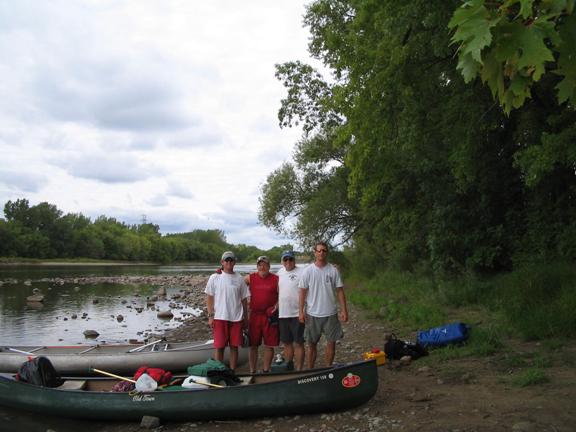Mississippi River Canoe Trip Journal
August 20-28, 2004
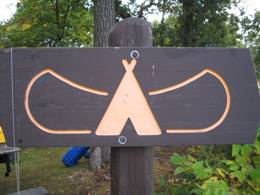
For years Noah and Steve grew up near the banks of the mighty Mississippi River, Noah in the Quad Cities (Rock Island, Illinois) and Steve in St. Louis. We watched the river flow by for years wondering what it would be like to be “on” the river. Yes, we’ve been in the river here and there but never afloat and adrift in the current. With the inspiration of Minnesota Boundary Waters-experienced University of Denver graduate student John Van Auken, we put together a trip; seven days on the Mississippi putting in at Brainerd, Minnesota and taking out in Elk River, Minnesota. Maybe someday we’ll canoe the whole thing, but this was a good start. The entire trip is about 2300 miles. Our short 120 mile adventure was just a beginning. Joining the crew was a “new guy.” Always risky traveling with new people but Chris Trice was a worthy partner. Chris is road savvy having just completed a 12,500 mile road trip of the United States. Chris moved to Boulder, Colorado from Richmond, Virginia four days before we departed but the adventurer in him could not pass up this opportunity to experience a Mississippi River trip.
We departed Denver, Colorado in Noah’s Dodge Durango with two canoes on the roof racks: a 30-year old 18-foot Grumman aluminum canoe and a 16-foot plastic canoe from the Old Towne Canoe Company of Old Towne, Maine (with “Property of DU” faintly handwritten on the bow). On the back of the truck was a storage shelf with most of the camping gear lashed tightly and many of the small items securely strapped in the canoes. This left room in the car for folding down a back seat allowing a tired Noah to nap much of the 16-hour drive to Maple Grove, Minnesota. Only Noah would stay up until 2:00 a.m. the night before a road trip. Where does he find the energy?
Sharing the driving amongst four made for a fast trip. The highlight of the day was exiting Interstate 35 in Albert Lea, Minnesota for Friday night pizza and beer at Jake’s. Upon a good recommendation from our waitress, we then walked over to The Nasty Habit for a final round of beers. Thank you Noah for assuming the role of Designated Driver! (Can you believe that?) We finally made it the home of our Minnesota host’s house, Mike and Tammy McGee. Tammy was out but Mike stayed up for a while as we reminisced about Mike’s former tenure at the Law Enforcement Center at the University of Denver.
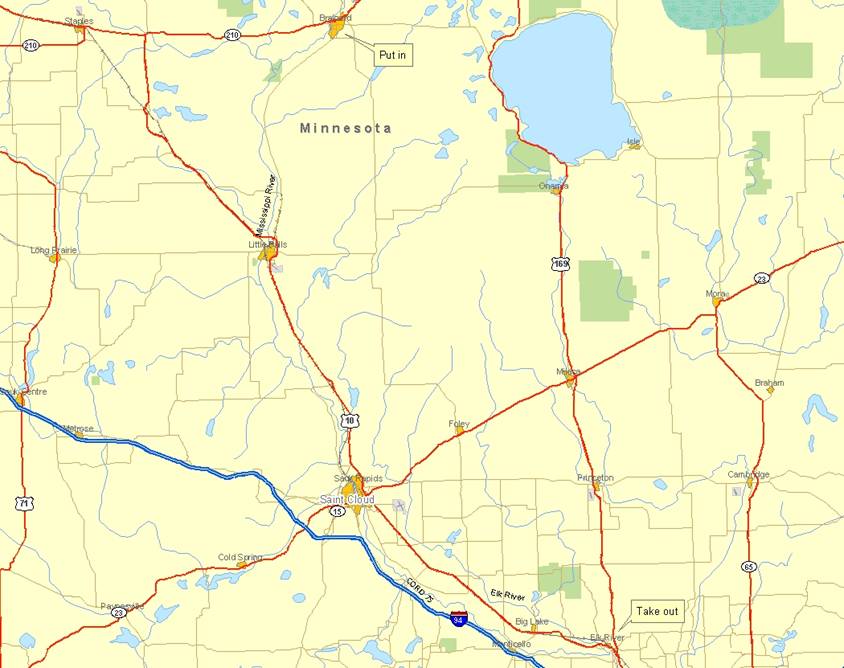
For detailed river maps, visit the Minnesota Department of Natural Resources website about Mississippi River canoeing.
Saturday, August 21, 2004
The day started early with our last showers for a while. Then it was back in the truck for the two hour drive to Brainerd for our put in. On the way we gassed up and Steve ran into Target to purchase a new digital camera since by this time we realized that Noah had left his in Denver! Oh well… I needed a new digital camera. The photos you are about to see were taken with the new camera so apologies are in order for taking pictures while learning the tips and tricks of digital photography.
Upon arriving in Brainerd, Mike dropped John and Steve off at the discount grocery store to shop for provisions while Chris and Noah went to the river to unload the truck and get the rest of the gear together. What can we say about shopping? Light to carry and lack of refrigeration were the rules guiding our purchases. We ate a lot of noodle dinners, but more on that later.
At 3:40 p.m. we finally put the canoes in the Mississippi River and we were southbound into a stiff headwind. This would not be the last headwind we faced.
We only had 11.5 miles to canoe the first day taking out at Crow Wing State
Park. We camped in a group site shared
with two kayakers on a similar yet shorter trip than ours. Cub Scouts and parents from St. Cloud,
Minnesota also took up space and they turned into useful friends. Dinner was the first of several noodle
meals. Ask Noah when you see him about
how much he likes noodles. After a visit
from the park ranger (a nicer park ranger hasn’t worked the visitors since
Steve retired from the National Park Service) we learned of an evening program by
wildlife photographer Bill Marchell. (http://www.billmarchel.com) Needing a ride to the park amphitheater, we
talked to the scouts and quickly hopped into the bed of one parent’s Chevy
pickup for the dusty ride across the park.
After a great slide show we trucked back to camp and called it a night
for tomorrow was going to be a long day.
Of course the night would not be complete without some pounding rain and
some of the brightest lightning we’ve ever experienced. This lightning was extremely bright even with
our eyes tightly closed in an attempt to sleep.
Sunday,
August 22, 2004
After our own breakfast of bacon and eggs, we were invited to the Cub’s camp for the remainder of their French toast or “freedom toast” as the joke went. Knowing that nourishment was vital to our paddling success, we obliged.
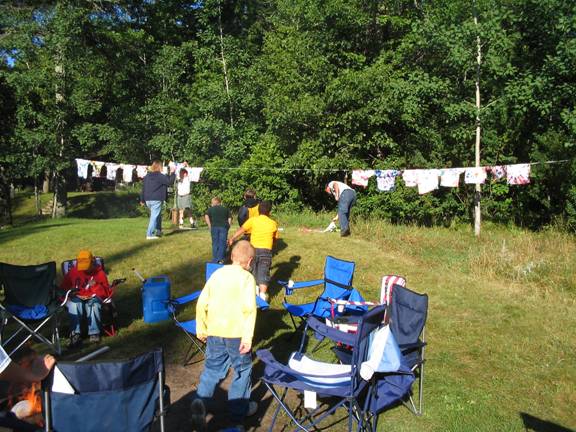

While you may expect Cub Scouts to generate a lot of laundry naturally, this weekend outing for them included tie-dying t-shirts. One was left with a vision of the 1960’s, but I don’t think even these parents spent much time in colorful T’s in their day.
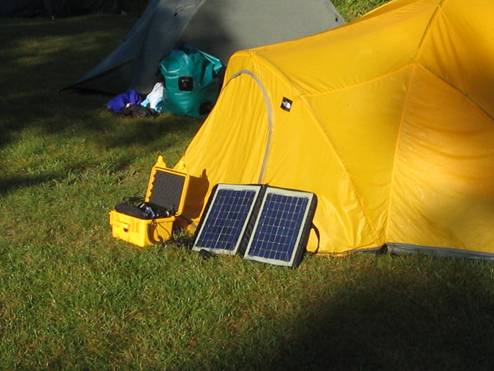 An
experiment in mobile technology
An
experiment in mobile technology
This trip was also an experiment in mobile technology for
Steve. Packing a five-year old Compaq
iPAQ (little lost if it got a little wet) with a GPS antenna and wireless
Sprint PCS card, a new Canon digital camera, and University of Denver Geography
Professor Matthew Taylor’s solar panel charger, I was going to attempt to take
digital pictures, record coordinates, and send pictures en route back home via
email. OK, we weren’t very far from
civilization but it was worth a try. The
GPS came in useful often to verify position.
Our map reading skills were excellent and we did a good job locating our
position estimating time and distance traveled.
The wireless Sprint card had limited applicability working near towns
but not at all in between towns. All of
this technology was predicated on being able to recharge internal batteries in
the handheld PC. Solar charging requires
intense and direct sunlight, a commodity available the first morning of our
trip and the afternoon of our second to last day on the river. Other than that we had a lot of gray,
overcast skies, great for keeping the temperature down. Noah was able to get sun-burned by the second
day, none-the-less. The handheld PC was
limited to spot GPS readings. Get a
handheld GPS receiver and carry a lot of batteries in the future. Extensive recharging was available in St.
Cloud, Minnesota carrying the technology through the final days or the trip.
Finally at 10:00 a.m. on Sunday morning our canoes were in the water and we were off on an 18-mile paddle to our next camp destination – Fletcher Creek Landing. The majority of the day was spent canoeing along the south along the eastern boundary of the Minnesota National Guard’s Camp Ripley. Signs posted along the river identified a “State Wildlife Refuge” but no mention of the military post. We spotted numerous deer and to our surprise, numerous bald eagles. One of the trip highlights was the thrill of watching eagles take off and land all around us, often swooping past the canoes from bow or stern. We saw more bald eagles than any other form of wildlife – excluding mosquitoes.

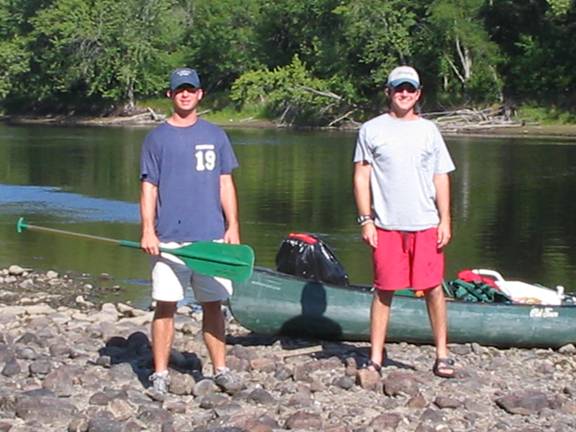
We arrived at Fletcher Creek Landing 4:00 p.m. and discussed options surrounding paddling on – we chose not to.
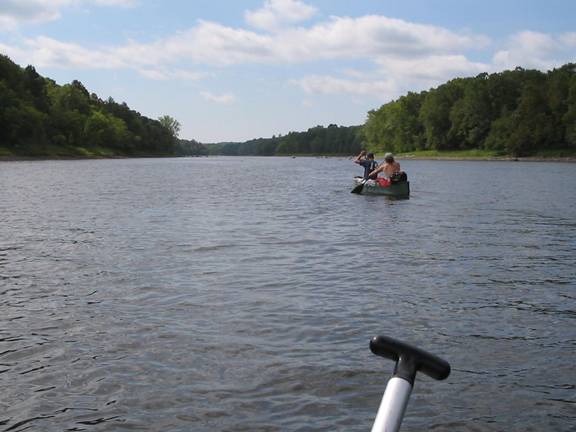
Noodles for dinner! John built the campfire after reassembling a previous attempt.
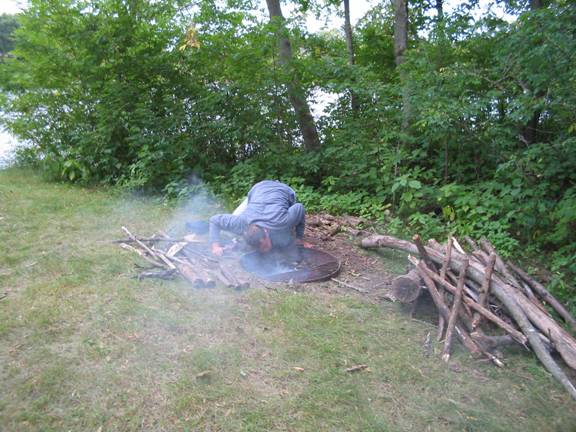
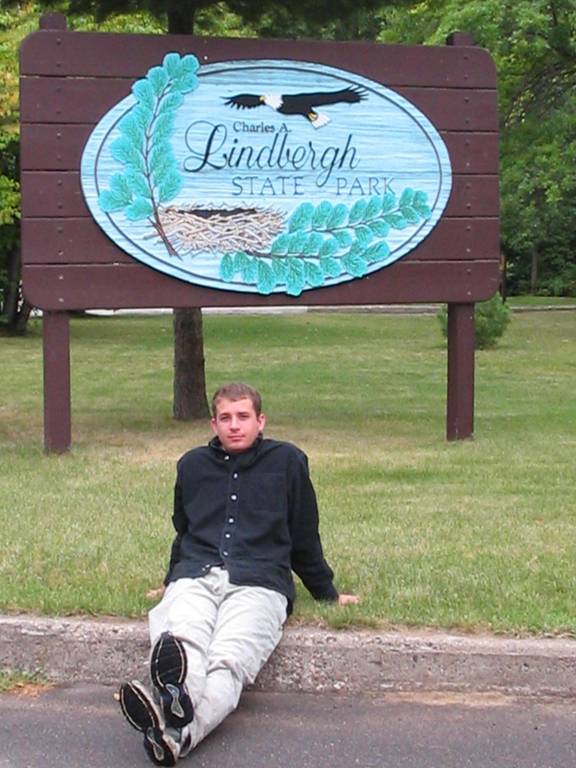
Monday, August 23, 2004
Our third day on the water was a “short” day traveling 10 miles from Fletcher Landing to Charles A. Lindbergh State Park. So you don’t have to look it up, Charles A. Lindbergh was a Congressman from Minnesota and father to the famous aviator Charles Lindbergh. Their family farm was donated to the Minnesota Department of Natural Resources.
Our third day on the water introduced us to extensive flat water paddling because most of this stretch of river was behind the Little Falls Dam in Little Falls, Minnesota. Leading up to the dam we paddled into a stiff headwind and battled to keep the canoes pointed toward our goal. At the dam we figured out how to get a week’s worth of gear around a dam on a 325 yard portage. The portage was relatively easy with most of the pathway through a town park.
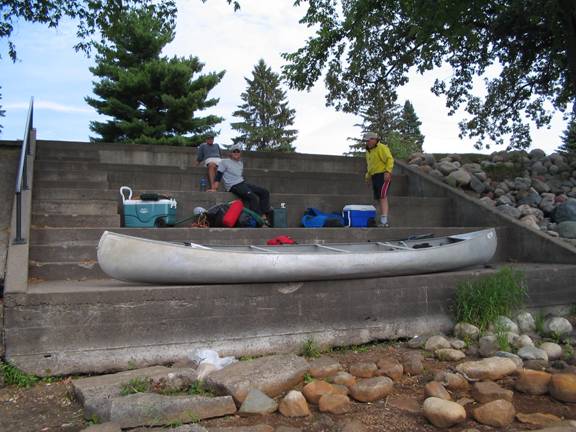
After our portage we walked uptown and had a burger lunch at the Red Bull Bar. There we learned to refer to the town as our waitress did – “Small Falls.” We paddled on to the state park where we “disappointed” a father hoping for seclusion for his family in the canoe camp site. He suggested we might want to paddle another seven miles into the rain and into the wind to find another campsite. We stayed put.
From the park we called a cab to take us to a movie and dinner in Little Falls. We went to see Without a Paddle. Save your money and skip the film, but the movie title was too good to pass up on this trip. Our cab driver was a character. She was a weathered woman allegedly of Ojibwe descent.
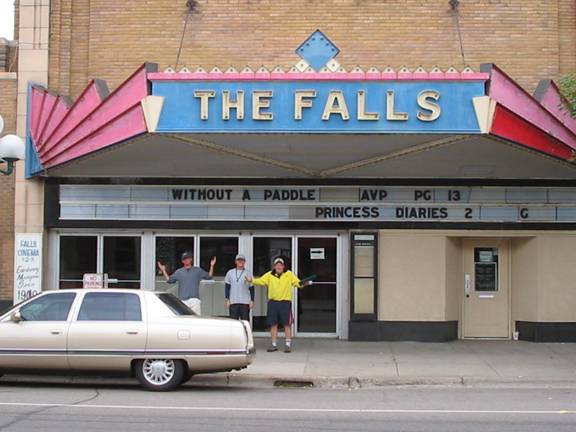
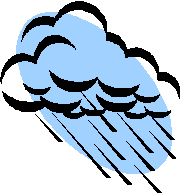 Did I
tell you that after our 10:00 p.m. cab ride back to the park it rained
again? It was a soggy day and night and
there was more to come.
Did I
tell you that after our 10:00 p.m. cab ride back to the park it rained
again? It was a soggy day and night and
there was more to come.
Tuesday, August 24, 2004
Tuesday was a long paddle day so we got in the water by 9:20 a.m. We had 22.3 miles to paddle from Lindbergh State Park to Stearns County Park. The first 7.5 miles was a lake piled up behind the Blanchard Dam where we anticipated a short 127-yard portage. The paddling was difficult into the wind with an annoying drizzle. Fortunately the temperature was in the upper 60’s so we kept warm with constant paddling.
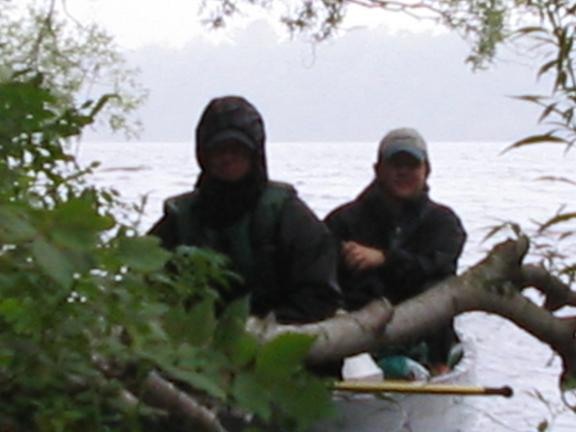
The most unusual event of the day was a wildlife incident. While passing a beautiful lakeside log home we spotted a deer on the deck. Of course it looked real but such a tacky yard ornament for this area. Then it moved! This whitetail deer was browsing off the patio table.
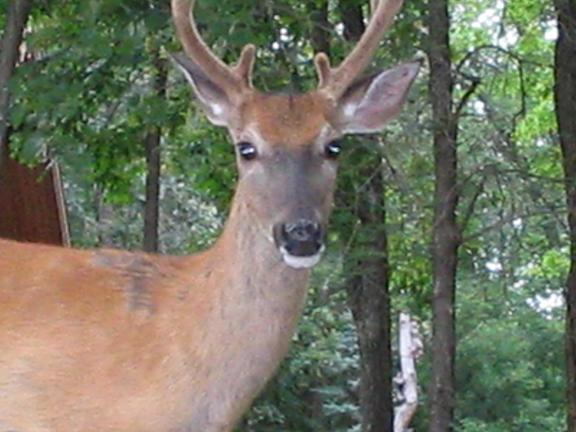
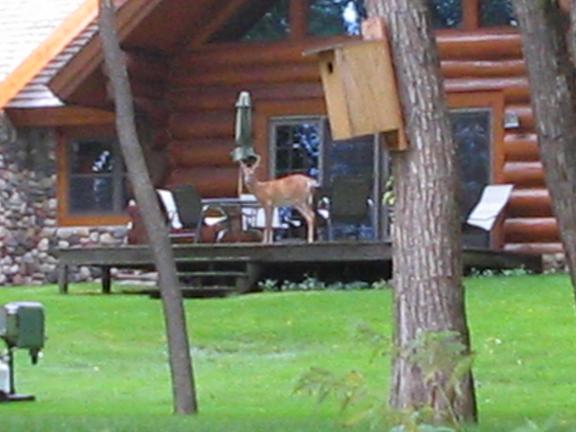
After paddling closer to shore, this tame deer approached and probably would have eaten from our hands if we had food to offer. Do you think he/she would like noodles?
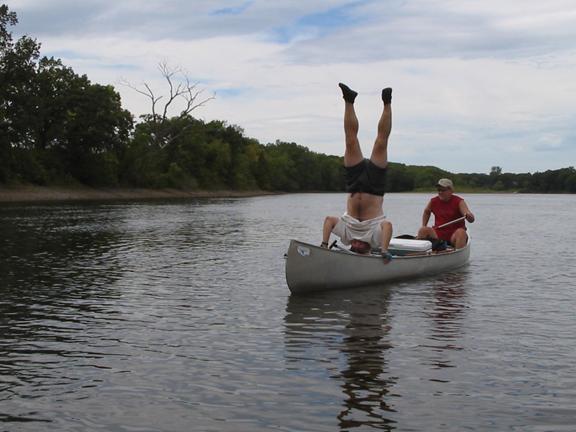 The
Blanchard Dam portage was difficult.
Some warning on the map would have been helpful. It was certainly longer that 127 yards and
the descent below the dam was treacherous at best. After portaging the gear we dined on our now
usual lunch of sausage, cheese and bagels at the foot of the dam.
The
Blanchard Dam portage was difficult.
Some warning on the map would have been helpful. It was certainly longer that 127 yards and
the descent below the dam was treacherous at best. After portaging the gear we dined on our now
usual lunch of sausage, cheese and bagels at the foot of the dam.
Below the dam the route closely resembled a river again! There was a current and even a few obstacles to navigate around. By day four we were settling into a fairly predictable three miles per hour paddling speed so navigating could be done as much by a watch as by a map. The current allowed us to drift and do some clowning around in the canoes. Yes, that is Steve and John’s disbelief in Steve’s ability to do a canoe headstand cost him one lunch bill. Not bad for an old man!
Tuesday night’s camp was relatively primitive in Stearns County Park. The woods were dense and we probably had our worst night of mosquitoes on the trip. Even then, with ample bug juice, they weren’t that bad. All in all, the bugs were of no major concern on this trip.
Wednesday, August 24, 2004
Day five on the river was to be a short 13.5 mile day terminating in the St. Cloud, Minnesota metropolis. We didn’t get on the water until 10:50 a.m. and the day included a 300-yard portage around the Champion Dam 4.5 miles before downtown St. Cloud. We didn’t start late because we are that lazy, but rather because visibility was poor. We woke up to a pea soup fog that just didn’t inspire us to hit the water. After the fog cleared we got under way towards the portage. The portage was relatively easy on the west bank opposite the Champion International Paper Mill.
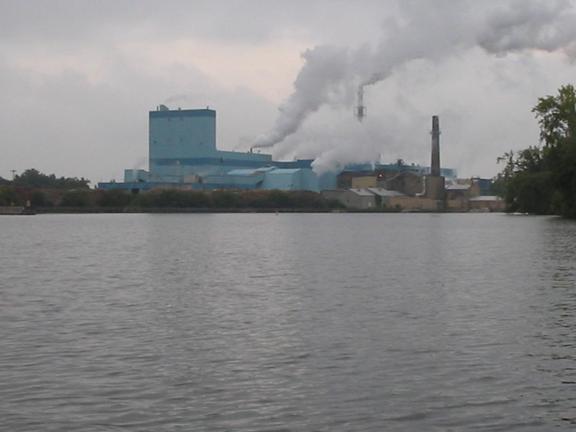
We greatly anticipated some fun in the Sauk Rapids about 12 miles into our day. These were the only rapids identified on the river maps and they indicated class I to III. The water was low and we went through the rapids with little difficulty.
We arrived in St. Cloud around 4:00 p.m. and after having paddled downtown hoping to find a place to take out, we made a cell phone call from the canoe to the Best Western Kelly Inn to find out we were right below it. We had to paddle about 2000 yards back upstream to take out. After unloading, we locked the canoes and some camping gear to a tree and then hiked the five blocks back into town where we wimped out and stayed in a hotel. OK, so we planned this all along but we wanted to have a little fun in St. Cloud. The weather was awful with tornado warnings in the area so the hotel idea looked like a good one. Mike and Tammy McGee drove up from the Twin Cities to join us for a nice dinner. Noah took off for some bar hopping after dinner while the rest of us made phone calls to our families and turned in for a good night’s sleep. I never sleep well a first night in a hotel so I suppose it was of limited value but the bed was a bit more comfortable than a Thermarest sleeping pad. I’ll still take my North Face sleeping bad over hotel sheets any day.
Thursday, August 26, 2004
Thursday was going to be a long day so after a hotel van ride back to our put in north of downtown St. Cloud, we got on the water by 8:40 a.m. Within two miles of our put in we had to take out and portage 303 yards on the left bank around the St. Cloud Dam. This was perhaps our easiest portage and the best news was that it was our LAST portage. After the dam it was all river the rest of the way where even the flat water maintained at least a 1.3 mile per hour current. That was in the slow places. Flat water until this point meant no forward progress and backwards progress if we were facing a headwind. We began to make our best time yet on the river covering as much as five miles per hour. We drifted and talked and probably did more conversing on these stretches as in any previous days – at least on the water. Camp was always filled with spirited banter as we shared our pasts, present, and future.
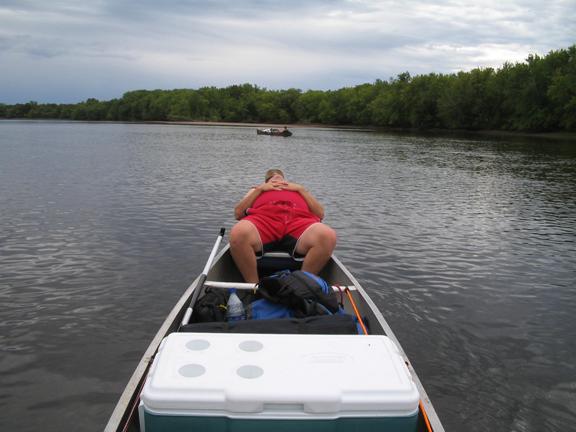
The river was beautiful and we continued spotting eagles, herons, and osprey. River turtles continued to take to the water sliding off river rocks as our canoes approached. You’d think photographing turtles would be easier! Maybe we need a turtle blind? That is an inside joke after listening to wildlife photographer Bill Marchel on trip day one.
Camp Thursday night was our favorite without question. We made camp at a primitive site on Oak Island after a 22.5 mile day. The paddling was easy and we all felt good. We were in camp by 3:30 p.m. and had time to read, contemplate life, nap, whatever.
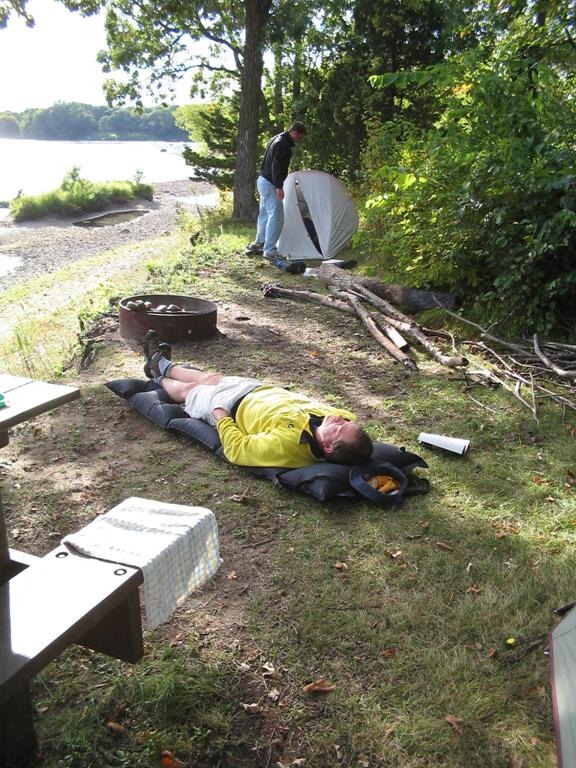
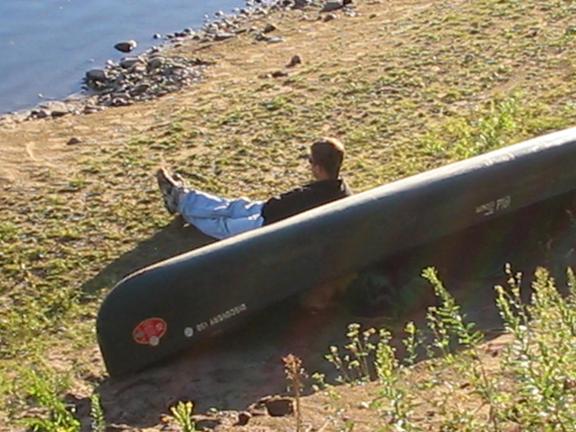
Our last noodle dinner of beef stroganoff was heavily seasoned with green pepper and onion as well as leftover sausage from our lunch at Boy Scout Point earlier in the day.
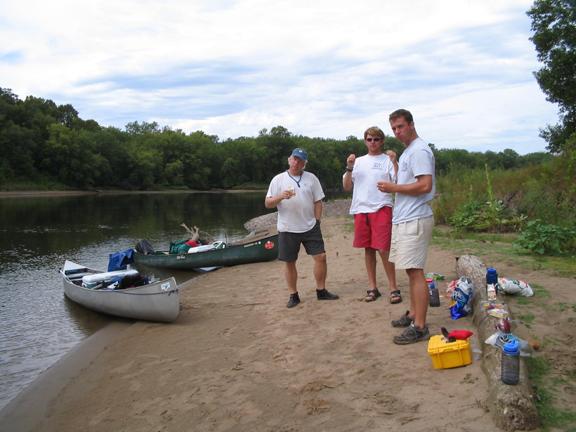
We built our second and last campfire. Campfires are much easier when someone else leaves wood behind from a previous visit. Note to future canoe travelers – bring a small hand ax or wood saw to cut firewood. There is plenty of wood available along the river banks.
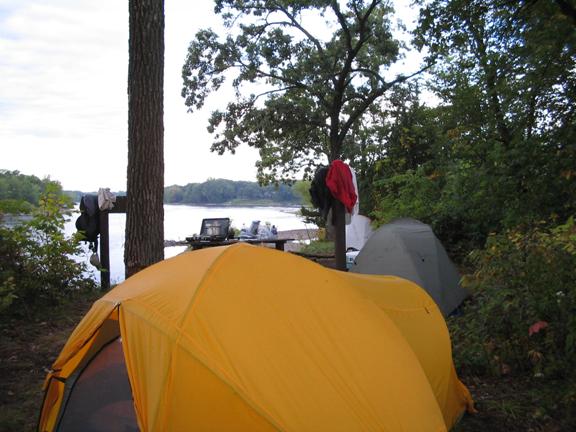
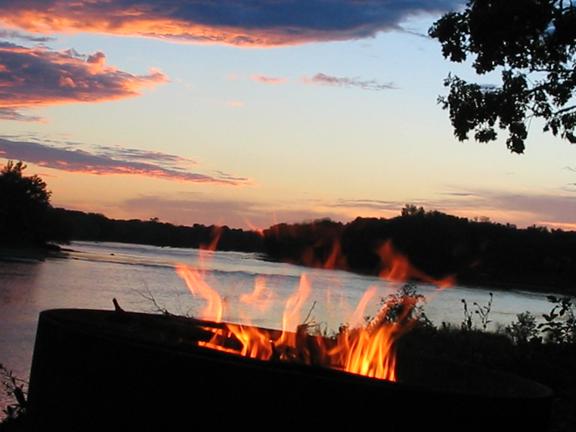
For the first time we had a cloudless night and the gibbous moon lit our campsite most of the night. This was an unusual place in the river that ran east and west. Our southern exposure allowed us to watch the moon arc completely in front of us.
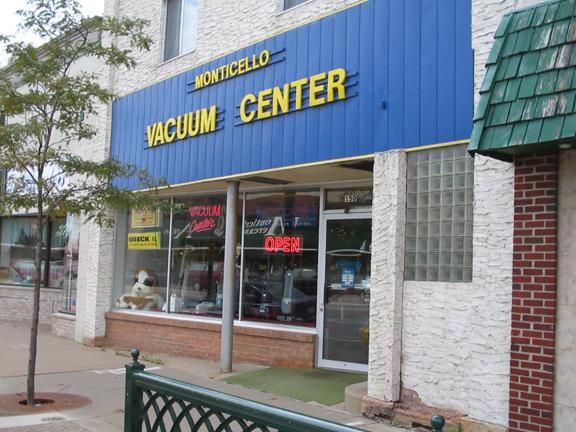 Friday,
August 27, 2004
Friday,
August 27, 2004
Our last day on the river was another long day covering 23 miles. We put in at 8:40 a.m. and headed east and south towards the town of Elk River, Minnesota where Mike McGee was leaving Noah’s car early in the morning. The river ran swiftly offering plenty of small boulders and shallow riffles to navigate through. We covered the miles quickly and took the opportunity to have a big pizza and beer lunch at the pizza factory in Monticello, Minnesota. Very few of the small towns along the river actually come up to the river bank. Monticello was second only to Little Falls for urban accessibility. And it was a good thing we stopped! Chris ran into the Monticello Vacuum Center to look for that hard to find Dirt Devil rubber belt and he found what he was looking for! It is great to know that Chris’ new Boulder apartment will be clean.
After lunch it was a 13-mile sprint (not a sprint – just really dedicated paddling) to the Elk River take out. We landed at 3:15 p.m. having made excellent time on the day. We logged approximately 120 miles. It was a great trip. We met interesting people and made new friends. Isn’t it interesting how we can spend a week in the woods and still come home talking about people. I guess that is a reflection on us. The wildlife was great and we were fortunate to see what we did. We all have new stories to tell and you can be sure you will hear about them.
Our truck was waiting and we loaded it up. One thing was slightly different upon our return. There was a fresh Bush-Cheney sticker affixed to the bumper courtesy of one of Minnesota’s rare Republicans, Mike McGee. If you know Noah’s political leanings you know the fate of that bumper sticker. We packed the truck and hit the road again – destination Albert Lea, Minnesota and The Nasty Habit. We drank a few celebratory rounds of beers and even a shot of tequila to wind up our trip – or was it over yet? One of the friendly Albert Lea patrons encouraged us to locate the town’s armory where a local live band was performing for a fund raiser to raise cash for Albert Lea’s sesquicentennial celebration next year. We made our $10 cover charge “donations” to the cause and watched the locals dance the night away. It was a good thing the last dance was at midnight because we still had a two hour drive to Des Moines, Iowa and the home of Noah’s sister Celeste. We found our respective sleeping quarters and bunked down for the night in preparation for our ten hour drive on Saturday to our Denver, Littleton, and Boulder homes.
We hit the road late Saturday morning at 10:45 a.m. and with the magic of power conversion, this trip journal was compiled on the long road home…
